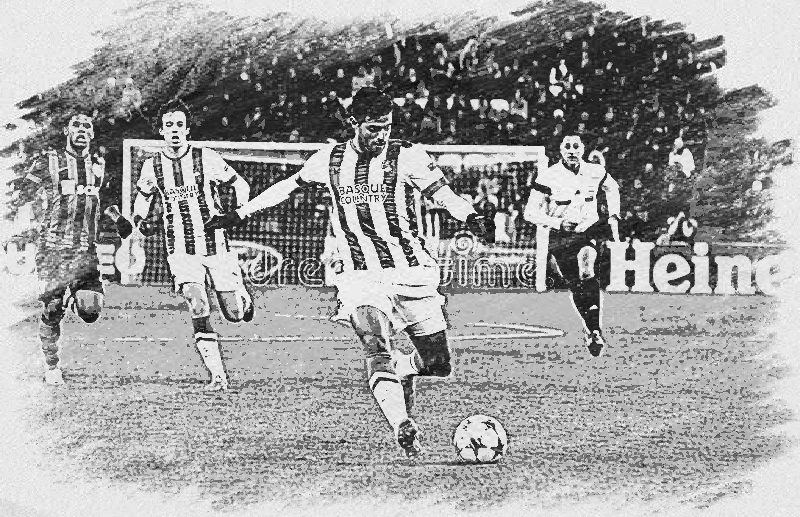
Total Football Journeyman: Total Football Mentality Ladder
When I first decided to create a Total Football tactic for FM22, I did not have 3-4-3 Diamond in mind. That came later. I only settled on Cruyff’s historic “Dream Team” formation after realizing that it possessed all the elements needed to achieve the objectives that I set out for myself at the start of this project. The goal was to recreate Total Football within FM22 as accurately as possible. In order to achieve this, the following will be my tactical goals. Basically what I would like my team to achieve on the pitch with our tactic.
Tactical Goals
Progressive Possession – avoiding “pointless possession” and stereotypical Tiki-Taka football. I really don’t want to win by a thousand sideways passes and uninspiring results. The fewer 0-0s and 1-0s the better). Possession needs to have intent and clear vertical progression. And we need to move the ball up the pitch with style and determination.
In Johan Cruyff’s own words: “Quality without results is pointless. Results without quality is boring”. And of course my all-time favourite, “I’d rather win 5-4 than 1-0”.
Building Up From The Back. At the same time, I don’t want my keeper or defenders mindlessly booting the ball towards my forwards. We need to establish a strong system for building-up attacks from the back. It’s one of the main advantages of possession style football. When you are a good team with highly technical players, you’ll want to increase your time on the ball. This will allow your players more chances to craft out good plays. And part of this is limiting the amount of low-chance passes and crosses. I hate seeing long hoofballs from my defenders and keeper. So the very first thing I’ll show in this guide is how to limit those.
Maintaining Control Over The Ball. While I won’t spit on a good counter, Total Football is not about that. We are not in the business of waiting around for another team to make a mistake. Total Football is the business of controlling your own destiny on the playing field. Total Domination of the game. You win or lose based on YOUR actions on the pitch. Not what the other team does or does not do. And the formation’s Diamond in midfield is key in seizing control over the pitch. It along with the three-man defence are among the most prominent features of the 3-4-3 Diamond. Here the selection of players and their roles are especially important; good synergy between the roles and the attributes will ensure better ball control. More on that later.
High Pressing and Hard Work. Very very important in recreating Total Football style. That is because it is how the team is able to maintain its control over the ball. Your players have to be very good at taking the ball away from the opposition. And high press and work rate are instrumental in this.
A lot of younger Footballer Manager players might think of this as the ever-popular Geggenpressing. The favourite style for exploiting plug-and-play tactics and anyone looking for instant results. While the addition of more accurate stamina monitoring in FM22 might have reduced the effectiveness of Geggenpress as a universal win-all strategy, it still remains a viable tool in any possession-focused formation looking to control the ball as much as possible. Invariably the requirement of the high, hard press, is going to dictate the shape of our formation. Specifically the positioning of the wide forwards. But again more on that later when I discuss the formation and its roles.
Interchanging of Positions – Universality of Total Football. This is one aspect of Total Football that is probably the hardest to model in Football Manager. One of the main principles of Total Football of course is that every outfield player, no matter their original position, should be able to play every other position on the pitch. The keeper should act as the first playmaker by venturing outside the box to start the build-up with the defenders. And the striker should be capable of dropping deep to contribute in the midfield and press the opposition. Essentially, you want every player to be involved in all three phases of play; defence, transition and attack. The big question remains on how to best implement this in FM22. Once again individual mentalities and team instructions are key.
Building-up Possession and Playing Out From The Back
Generally, low individual mentalities are not ideal for playing out from the back. Or for creating the patient build-up by the keeper and defenders that’s the staple of possession systems, like Total Football. It might seem counterintuitive, but higher team mentalities are more conducive to this style of football. So sometimes, to play possession football, you need to use an attacking mentality. Why is that?
1) Problem with being too cautious
It is no secret that on low (eg. cautious) team mentality, defenders tend to play it safe. Moreover, this often means booting the ball upfield and away from dangerous areas near your penalty box. This makes sense when your intention is to play cautiously and defensively. But it is definitely not the behaviour we want from our defenders when trying to build from the back. Yet it happens all the time in FM. Even when playing on a positive mentality. And if you are new to the game, you might not realize what you are doing wrong. It can be very frustrating when you see this happen again and again. Especially because when you read the in-game description for positive mentality, it seems perfect for a possession-focused style like Total Football.
Patiently probe. Maintain possession. The very elements that we are trying to implement in possession football. Or that’s what the mentality description suggests. Except it is misleading. To understand this, one needs to understand that team mentality affects different roles differently. By setting a “positive” mentality for the whole formation, it doesn’t mean that all your players will operate with this mentality. While it is true that player mentality relates to the team mentality, the link is not direct. Defenders and players with Defend duty will always operate on the lower mentality level from the general team mentality. I call this concept the Mentality Ladder. Understanding and mastering how you can manipulate it is one of the first steps in creating a successful Total Football tactic. Or any tactic for that matter.
Even with a positive team mentality, your central defenders will operate with a “Cautious” individual mentality. A little bit of pressure from the opposition will make them go into defensive mode. And then look for ways to clear the ball to safety. Sometimes with no option but to boot it long over your midfielders.
2) Importance of Roles and Duties
Ball-playing Defenders are actually not ideal roles for when you want to have lots of possession and patiently build-up plays from the back. Especially if you use more than one in your backline.
Their role description says it all.
So think twice before setting up a whole backline of BPDs, just because you have technical defenders whose recommended role is Ball-Playing Defender.
Imagine you have two or more such roles in back three? Then read the second paragraph in the image above. Personally, I would only give this role to a truly special player capable of making those ‘Hollywood passes’ on a regular basis. That is a player with elite-level passing, vision and decision attributes. Maybe someone like Pirlo, who can also tackle and jump. Although if that’s the case then maybe he would be better utilized as a libero with more creative freedom. And If you do not have such a player then why not just utilize a simple central defender? He will make simple and short passes towards your midfielders and avoid the much riskier long ones. A simple centreback on cover duty will suffice in that case. Especially if you want your two wide-centrebacks to be more adventurous in how they progress the ball.
There are several ways to set up an effective back three in a progressive possession system. However, the most important thing to remember is balance. If your tactic asks two of your defenders to move forward aggressively with the ball, then the third has to be more conservative to preserve the defensive integrity of the formation and cover for the other twos’ movement.
Such a set-up does not need to be symmetric. For example, if your most creative, mobile players are your libero and left centreback then it is okay to set the left wide-centreback with a more conservative duty to provide balance to the backline. This will also let you assign more varied roles to your midfielders.
In this way, your right wide-centreback on defend duty will allow your mezzala to be more aggressive in his movement. Wide-Centreback (Defend) will tend to hold his position wide to cover for any potential opposition counters. And he won’t dribble forward and overlap as much as his partner on support duty. That is because, on the left flank, the presence of the more defensively-minded carrilero gives your left wide-centreback more freedom. The freedom to move forward and act like a real dynamic hybrid between a fullback and a defender.
So now that you have chosen your roles, there is another important element to keep in mind. What about the players’ individual mentalities?
For a progressive passing game, such as that required by Total Football, you need your defenders’ individual mentalities to be relatively high. “Defensive” or even “cautious” won’t really be sufficient to make them regularly bring the ball forward or standoff intense pressure from the opposition. Again, it makes sense because conservative play encourages defenders to take fewer risks. When faced with a choice between potentially losing the ball to the opponent’s press or booting it upfield, the defender will almost invariably take the less risky option of sending the ball further away from goal. That is because holding onto the ball and dribbling with is always the riskier choice. It will require more skill from the player to achieve success.
Higher the mentality, the more risks your players will take. But if you possess defenders with the right attributes, then why not let them take some risks?
When trying to play Total Football and build up possession from the back you will definitely need very technical elite defenders. Then to unlock their full potential you have to make sure that the tactic itself is allowing them to make full use of their skills. And that is why in a Total Football tactic, you will need to increase the risk-taking across the whole formation, not just the attack and midfield. To do this you need to find an overall team mentality that brings up the individual mentalities of almost all your players to at least “positive” or “balanced”.
Thus “attacking” team mentality might actually be ideal for a progressive possession game. As you can see in the image above, it really increases the individual mentalities of all the backline players, making them much more decisive with their on-the-ball decisions.
3) The Pivot Player – The Key to Possession
Ok, so you managed to give your wide-centrebacks a “positive” mentality. The next important step is building the rest of the formation around them. That starts with an important question. When your two ball-carrying Wide-Centrebacks bring the ball forward, are there other players in good positions to receive it? For once, you will need a midfielder staying back to offer a safer passing option. As well as to cover for the centrebacks adventurous movement. Hence a Half Back at DM position is a necessary role in a 3-4-3 Diamond.
Think of this player as your defensive pivot around which the rest of the players move. He is the bottom point of the diamond and essential in providing a point of stability that allows the libero (if you use one) and the wide-centrebacks to be more adventurous. He also has the lowest individual mentality in the formation – “balanced”. This makes him the player that is least likely to charge forward during the attack. You’ll need such a player if you want to start your attacks methodically and not be caught on the counter.
It goes without saying that your Half Back has to be a very good footballer. He does not need to be a very mobile one. But possessing some obvious defensive strengths (including jumping reach) will turn him into your fourth centreback at times. Especially when you lose possession.
Another reason why the defenders and/or keeper will boot the ball long sometimes, is the lack of passing options. Such as when the team in attacking and every single midfielder is set to “attack” duty with “get forward” instruction. Who will your backline be able to pass to then? Thus the importance of having a “pivot” player in defensive midfield. Then you are sure to have at least one passing option in your build-up.
Ultimately, the Half Back is the little engine in your Total Football machine. He does not roam around much, mostly staying central in his section of the field. But he does move up and down between DM strata and the backline quite a bit. That is part of his main function as the defensive pivot. However, he only drops back when the wide backs or libero dribble forward. In this way, he always provides a passing option to the other defenders or your sweeper keeper.
But even more importantly the Half Back needs the technical skill to be able to pick up and spread the ball ahead of him. This is shown in the diagram above. Hence the importance of having a player with great vision and passing ability in the DM slot. Perhaps someone like Ajax’ Daley Blind can receive the ball in front of the defensive line and see the whole midfield ahead of him. And due to the nature of the 3-4-3 Diamond, he should have numerous passing options available to him.
4) Importance of Keeping it Simple
Sometimes it is the team instructions that confuse the players and lead to opposite outcomes. For example, telling your keeper to “pass short” while playing with an extremely high defensive line. How do you expect him to make precise short passes when the defenders are too high up for such passes? If there are no short pass options available, even the best sweeper-keeper will gravitate toward long kicks. Therefore, it might be better to allow the keeper to make his own choices on the length of the pass. Instead, there is another way to limit his tendency to kick the ball over your defensive line towards the forwards. The only thing I tell my keeper is to pass to the centrebacks. This keeps his passing options relatively open, mixing up the short passes with the occasional medium-length kick. Moreover, you’re making sure that he is mostly targeting your three centre-backs.
Of course, there will be times when all three centrebacks are out of reach of your keeper. That is why including “play out of from defence” is also required. This instruction is essential in building up from the back. That is because it instructs both your centrebacks and Half Back to drop back towards your penalty area. In turn, facilitating their chance of receiving easier short passes from the keeper. While the Half Back should already drop back by default, with this instruction he should do so even more frequently.
“Play out of Defence” has another, more offensive, function. By dropping back when in possession, the centrebacks will pull the opposition midfielders with them. This is especially true when facing a high-pressing side like RB Leipzig or Liverpool. So when their midfielders try to press your ball-playing wide-centrebacks, they will invariably open up more space behind them. Space that your own midfielders can exploit. And that is why you want to have good passers with great decision making in your backline. To be able to see such openings and to act on them quickly. There is no room for hesitation or half-measures in possession football. It is Playing on The Edge to the max. Embrace it in FM22!
Progressive Possession and Ball Control – The Importance of One-Twos
There is one major difference between Cruyff’s 3-4-3 Diamond and Rinus Michels’ original 4-3-3 Total Football formation. By playing only three defenders, Cruyff was able to add an additional midfielder at the top of the diamond. Located just behind the striker, the attacking midfielder has a rather simple function. His role was not to hog the ball, dribble forward and take on players individually like a typical #10 playmaker. Cruyff wanted him to play short one-two passes with the central midfielders as a way to open up opposition defences. One-Twos are especially useful when trying to progress the ball in situations where very little space is available.
In FM22 “One-Twos” is a trait that increases the frequency of a player making a short pass to another teammate. And then immediately making himself available to receive the ball again, as he runs into a more advantageous position.
For one-twos the key attributes are off-the-ball and teamwork as well as the obvious technicals (passing, first touch and vision).
Passing, Vision, First Touch, Off The Ball and the obvious Teamwork are all essential attributes for one-twos. Your midfielders need to possess these attributes in order to achieve effective one-two passing patterns.
So firstly, both players involved in one-twos require excellent First Touch, Vision, Technique and Passing attributes in order to control the ball well and make a short pass quickly and accurately.
Then the player must have enough mobility (Acceleration and Agility) to move quickly into another position on the pitch to receive the pass from his partner. Then pass again if needed.
In order to receive the pass, spatial awareness and attacking movement play a great role. Thus both players doing one-twos must have strong mental attributes. Particularly Decisions, Anticipation and Off The Ball to spot the pass and decide when is the best time to run into it.
The player involved in one-twos would also benefit from a good Work Rate and Stamina to repeat this pattern of the pass and move throughout the game.
When performed correctly by skilled players, one-twos create a beautiful pass and move combinations. Nothing is more satisfying than seeing your players pass, move and then receive the ball again only to pass forward again. As an additional benefit, it makes it very hard for opposition defenders to deal with such a progressive movement. Even the tightest defences can be unlocked easily with a series of good one-twos. It is a good way to create space where there is not much space, to begin with.
But one-twos are not easy to achieve, and you need very good players with a very specific skill set. Players like OL’s Houssem Aouar have most of the required attributes. And at Lyon, you are also lucky to have two other midfielders with suitable attributes and “one-twos” traits who could slot in behind Aouar in the midfield diamond.
At least one midfielder has to have great off-the-ball and physical attributes (and perhaps good longshots as a bonus) in order to make runs into the half-space. This has a dual benefit of firstly drawing opposition to create overloads, giving more space to the forwards. Or if left unmarked provide another avenue of attack on the box. Originally in my tactic, I used twin carrileros but noticed that while they maintained possession well and broke up counterattacks, they were not giving us enough final third penetration. Timely game-breaking movement behind the forwards can mean the difference between a victory and a frustrating draw. Thus I switched to a carrilero/mezzala partnership. Although if you want to play it more safe (or don’t have the appropriate player) then I suspect carrilero/box-to-box midfielder partnership might work just as well. And for maximum dynamic movement – mezzala and box-to-box.
So the role of the AMC is rather simple in this. After performing a layoff pass towards one of the midfielders, he could run to receive another pass from them. Or he could act as a second striker by getting into the box to support the centre forward. But if one-twos are your ultimate goal then the role of the AMC and the choice of team instructions could be very important. It goes without saying that it’s helpful to have as many of your midfielders and attackers learn the “one-twos” trait. And their roles matter too.
Pairing a more mobile role like a mezzala or box-to-box midfielder with a more stationary one like enganche (or any other role that holds position) will naturally lead to give and go passing exchanges between the players. And team instructions such as “dribble less”, “work ball into box”, “focus play through the middle” and “low crosses” will increase the rate of layoff passes and one-twos even further.
Putting It All Together
Mentality: Attacking
As I mentioned before, the way I use team mentality is perhaps not the same way that others use it. I do not use “attacking” because I want my team to play a balls-to-the-wall gung-ho attacking style. Far from it. I only use it because it is the mentality that gives me the distribution of individual mentalities that I look for. Specifically the mentalities of my back three. With the Attacking Team mentality this is the individual mentalities that I get.
Note: My wingers’ mentalities are reduced by the inclusion of “overlap” instruction on both wings.
And because I am using more aggressive attacking team mentality, it is important to balance our directness quite a bit. I do this by including some specific in-possession instructions.
And as discussed in the section above here are all the defensive team instructions I use in my tactic. Not many, but all essential to our build-up from the back. Because we are playing in a narrow shape, it’s important to channel the opposition into the middle of the pitch. It is exactly where our formation gives us an advantage. It also has a double benefit of pushing our wide defenders even wider to cover the flanks better.
To encourage one-twos and progressive possession in the middle, these are the instructions that I went with. The jury is still out on whether low crosses make a big difference. For now, it makes sense because my central strikers are more in the mold of technical playmakers than tall targetmen. We also want to limit the floated balls or hoofballs from our defenders and wingers.
“Dribble less” is also something I believe should increase the frequency with which our players play “pass and move”.
While playing out from the back and progressive possession are both very important in recreating Total Football style, setting up high pressing traps is the other half of the formula.
I decided to keep the overall pressing urgency at the default level. I prefer to have my front four press more intensely while the rest of the formation keeps their defensive shape. It also makes more sense to run a split block like this due to the top-heavy nature of the formation. I dislike the popular uber-geggenpress strategy of having 10 of my players running around like headless chickens chasing a ball. I also wanted to make sure that our midfield diamond is preserved and we are well organized defensively, especially when faced with tougher competition in the Champions League.
This also happens to be the area where I ran into my first stumbling block with the tactic. At first, my idea was to run a formation with deeper wide midfielders. Mainly it was to recreate the hard-working nature of Cruyff’s flank players in the 3-4-3 diamond. I also liked the flexibility of the WM role. But upon testing with Real Sociedad and Porto, I found some things that I didn’t like about the wide midfielders.
Wingers
The big trade-off with wide midfielder’s deeper defensive position is their ability to press high. While the role can be instructed to press the opposition aggressively, it does not happen as easily as with a winger (in AML/AMR position). So this caused me to revert back to my earlier idea of using two advanced wingers. A hard-working player in this position will still mark and press the opposition very well. Also, I like how naturally wingers will provide width in a formation that already has a lot going through the middle. Where it gets interesting is in the types of players I prefer to use for my wingers.
Ideally, I want my wingers to cut inside via a player trait and not PI. This creates interesting patterns of movement in the final third. I especially like how with “cut inside” PPM, this movement does not always trigger but instead is linked to the player’s decision-making and the situation at hand. Sometimes he will cut inside, sometimes not. Also unlike with the hard-coded player instruction, the movement will happen later in our attack. The winger will hold the width until the final third where he will drift into the half-space around the box. Such behaviour also has the added benefit of avoiding the ever-present annoying cross from the byline. How many times did you see an opposition defender or fullback block that one?
Hard-working wingers will also drop back and support the midfield as dictated by their support duty and “overlap” instruction (reduces their natural attacking tendency).
I also tell both of my wingers to “close down more” and “mark specific position” (more on that in the following section).
Striker/AMC Duo
My central striker and central attacking midfielder are likewise essential to how we execute our press. Having all four attacking players in advanced positions helps us in winning the ball back as soon as it’s lost. I also remembered one important fact about Cruyff’s CAM player. He often acted practically like a second striker. His duty was to push up when necessary, but he would only play as a midfielder when there was an overload. When Bakero played in this position he enjoyed a very dynamic relationship with the striker (Laudrup or Romario). At times they would interchange positions, with the striker dropping back to help the midfield and the Bakero moving up to act as a striker. In FM, there is only one role that can work in tandem with a central striker in this manner.
Shadow Striker. A unique hybrid between a more creative midfielder and an all-out attacker. So when the role is there why not use it? Ever since FM14, I have been trying to get the best out of a Shadow Striker role. Seems like FM22 won’t be any different.
There are a few striker roles that can work well with a shadow striker. Principally, Shadow Striker pairs well with a False9 (if you have a more flashy, technical player) or a Deeplying Forward (more physical Targetman-type player with some technical skill). I decided why not try to pair him with a well-rounded player that has a bit of both.
There are advantages to playing a well-rounded jack-of-all-trades as a striker. Especially when playing with a sole central striker, you need a player that can do a bit of everything. This way you will be sure to create chances no matter what opposition you face. Sort of like Romario in Cruyff’s Dream Team, a Complete Forward is a great role that brings a ton of variety and unpredictability in its patterns of movement and attack. At times he will drop deep and exchange places with the Shadow Striker. At other times he will push forward and pin the opposition defenders back to give more space to the wingers.
Central Midfielders
Like the above-mentioned striker/CAM partnership, this is another important pairing in my tactic. It also changed quite a bit from my initial conceptualization of the tactic. I finally settled on the trusty combination of mezzala and box-to-box. It worked very well together in the FM21 iteration of this tactic and still seems to be the case in FM22. Although in games against tougher opponents, I sometimes change the B2B into a carrilero. The mezzala acts as my “needle” player to make runs high up the pitch. That is the player that provides dynamic game-breaking movement behind the forwards. It is definitely the more creative, offensive player with exceptional ball control. Box-to-box midfielder on the other hand is the tougher of the two. He is not as much a half-space merchant as his mezzala partner. The B2B balances his attacking and defending duties very well.
Centrebacks and Half Back
I already discussed my defensive trio and the halfback at length in the previous section, so won’t cover it in the same detail again. The main idea is still to have a higher individual mentality on the two wide centre-backs in order to encourage them to move laterally and up the field to overlap and support the midfielder. At the same time, the central defender and the half-back will provide defensive cover at the base of our defensive diamond. For that reason, I keep their individual mentality lower than the wide defenders. Depending on your players, you could also use an asymmetric trio of one wide centreback on support duty, libero in the middle and another wide centreback (defend).
Player Traits, Individual Instructions, and Specific Marking Instructions.
Individual Instructions
Encourage traits like “Brings ball of out defence”, “try to play out of trouble” (only if the player has good dribbling) and “dictate the game”. While avoiding ones like “attempts long passes”, “killer balls”.
Both Wide CBs – Mark Specific Position. Told to mark their respective wide attackers. This is very much opposition formation dependent. So could be MR/ML or AML/AMR opposition players. Depends on the opponent’s formation. In all cases, your player marks the opposite player. This means that a player on your left side will mark a right side opponent.
Central CB – Mark Specific Position. Marks the opponent’s Central Striker
Half Back: Take More Risks. Close Down Less. Mark Specific Position. Marks opposition AMC player or their second striker. Again it depends if the opponent is using a formation with two strikers or a central attacking midfielder.
Mezzala: Take More Risks – this is my more creative player so I make sure he gets more freedom to create without using a playmaker role. Run Wide With The Ball. I use this latter instruction on both of my midfielders in order to stretch the space in the midfield and facilitate their movement into half-spaces.
Box-To-Box Midfielder: Run Wide With The Ball.
Both Wingers: Mark Specific Position. Instructed to mark opposing fullbacks if available.
The front four – Striker, Wingers and CAM – Close Down More. Used to create a split block pressing.
PPMs (Player Traits)
In terms of unique player traits, I prefer less to more. So the following ones are really the most essential traits that help to create our preferred playing style.
One-Twos – on Striker, CAM, Mezzala and B2B. If your wingers possess this trait already then it’s an added bonus but I won’t go out of my way to teach them this. It won’t make as much of a difference as with the central players and will take up valuable training time.
Comes Deep to Get the Ball – for my central striker. This trait it will allow greater flexibility of roles. Such as using more attacking roles like Complete Forward (Attack) or DLF (A).
For my back three, I encourage traits like Brings Ball of Out Defence, Tries To Play Out of Trouble (only if the player has good dribbling). While for the most part avoiding ones like “attempts long passes”, “killer balls” (unless the player has an exceptional playmaking ability).
Finally, those looking to test the tactic out in their own save, here is my Link to tactic download. Thanks for reading!
And if you enjoyed this article, then please follow us @ Dictate The Game’s Facebook and Dictate The Game’s Twitter.
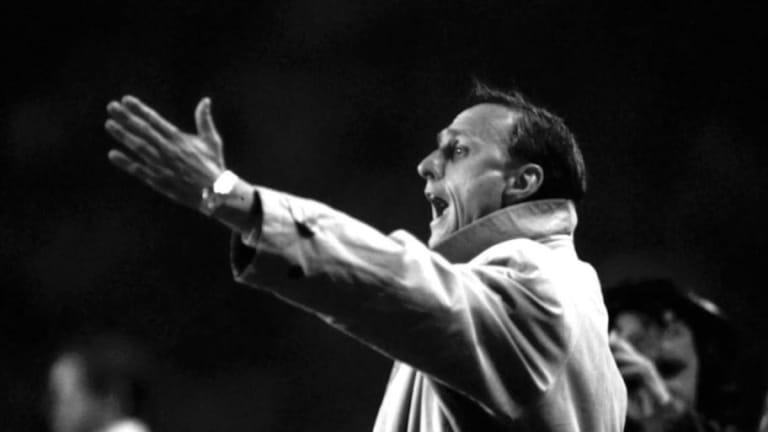



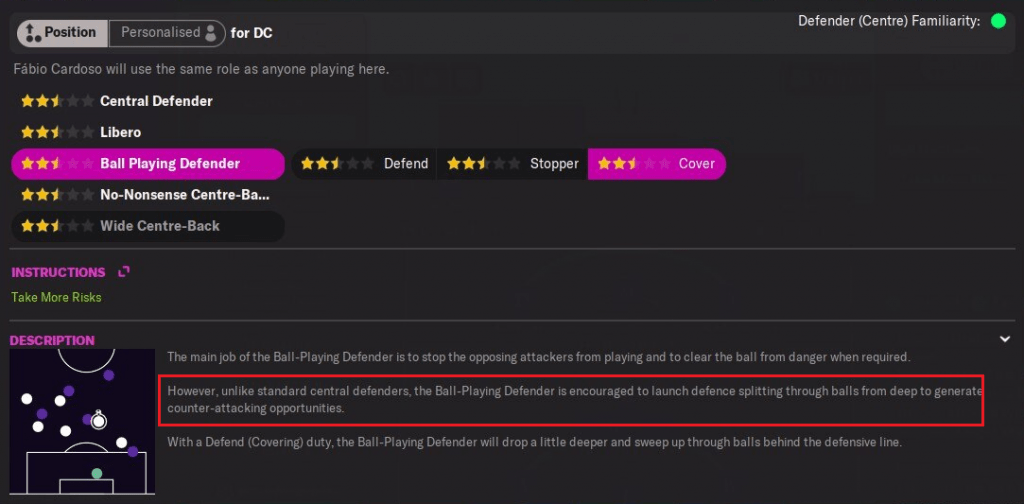


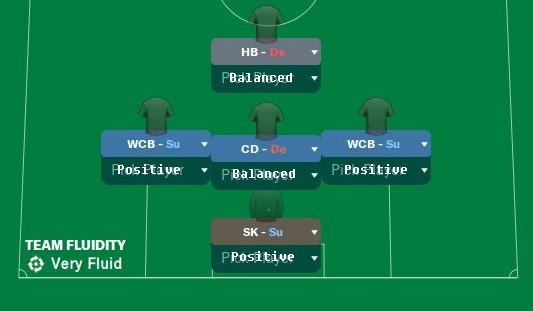
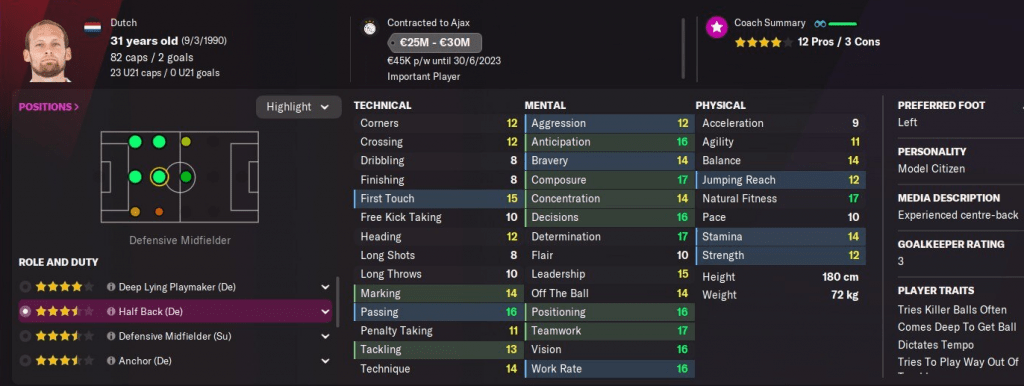
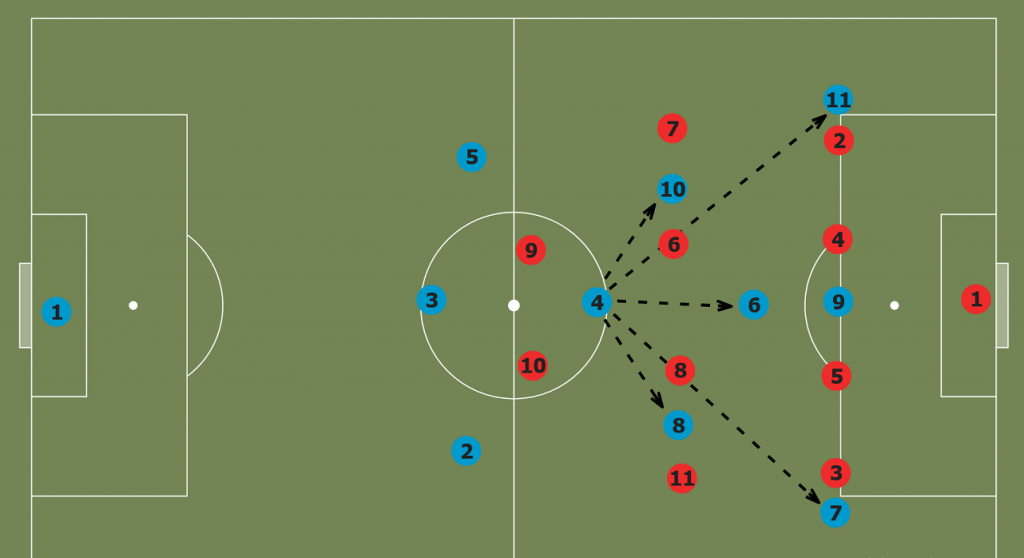
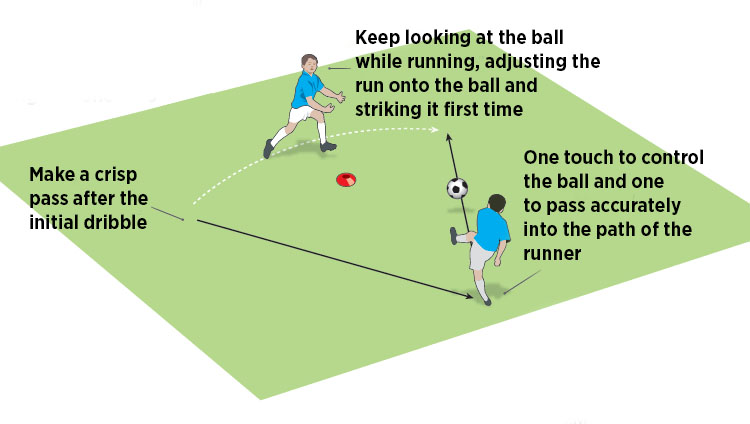


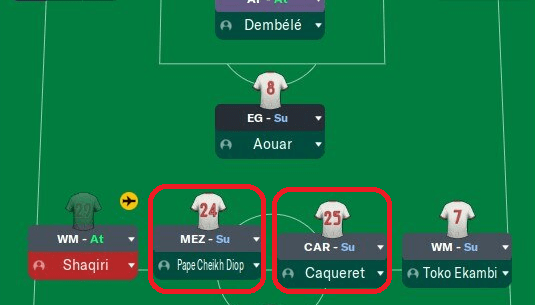



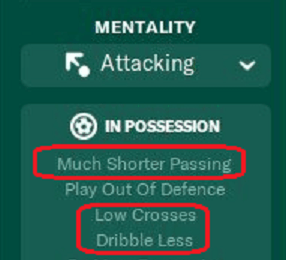
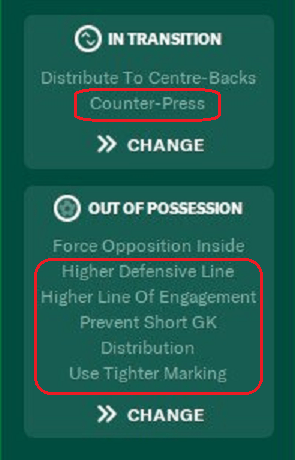
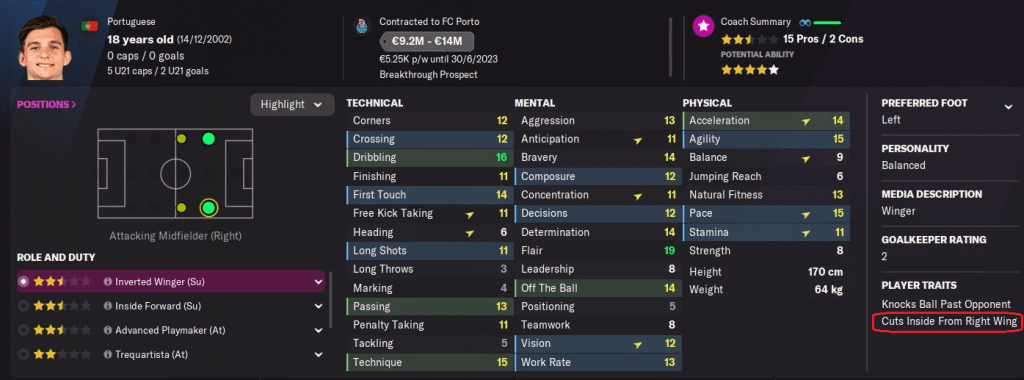




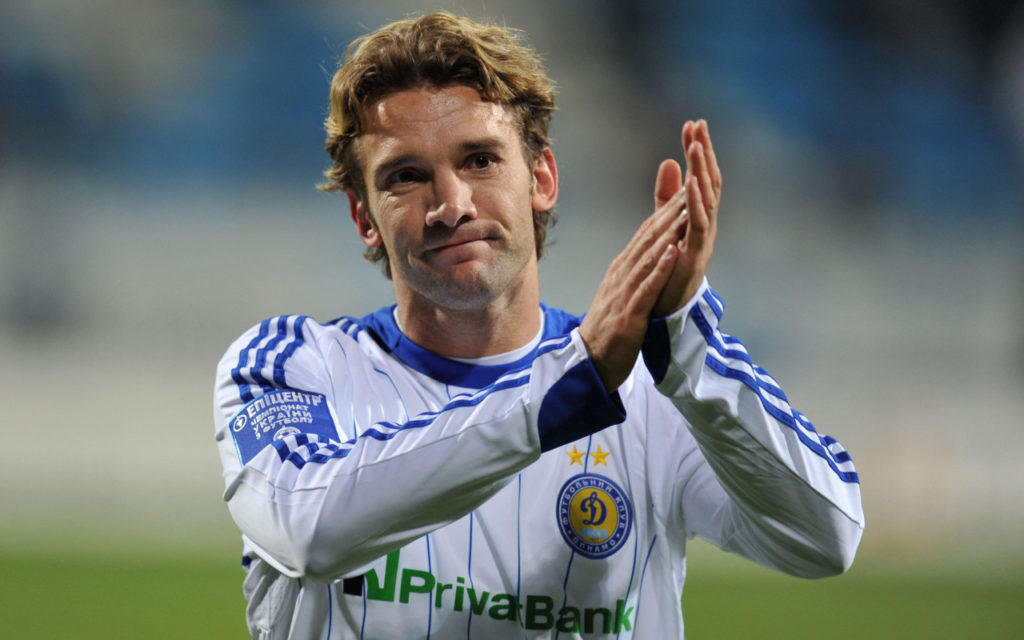
5 thoughts on “Total Football Journeyman: Total Football Mentality Ladder”
Hey crusadertsar, I’d like to try your 3-4-3 as I’m quite the fan of the TF concept, but my browser is blocking your download link as unsafe? Any other options?
If you frequent the SI forums (for football manager games forums). I posted another link for the download (my updated 3-4-3). Its the “Everything Total Football” thread on the main page of Tactics section of forum. Its on page 22 of the thread I believe. Hopefully that works for you! If you cannot find it then let me know and I will try to post a direct link to it on here.
Really enjoyed the article as well, thanks!
Glad you enjoyed it! Cheers!